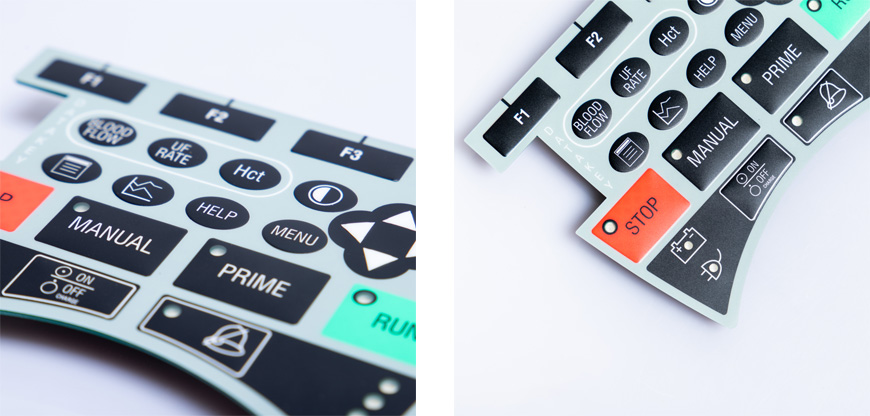
In today's fast-paced world of technology, we often come across various electronic devices that make our lives more convenient and efficient. One crucial component that plays a significant role in these devices is the membrane switch overlay. In this article, we will delve deep into the world of membrane switch overlays, exploring their applications, benefits, and much more.

1. Introduction
2. What is a Membrane Switch Overlay?
3. The Anatomy of a Membrane Switch Overlay
Layers of a Membrane Switch Overlay
4. How Do Membrane Switch Overlays Work?
5. Applications of Membrane Switch Overlays
In Consumer Electronics
In Industrial Control Panels
In Medical Devices
In Automotive Industry
6. Advantages of Using Membrane Switch Overlays
7. Customization Options
Graphic Design
Tactile Feedback
8. Membrane Switch Overlay Manufacturing Process
9. Choosing the Right Membrane Switch Overlay
10. Maintenance and Care
11. Future Trends in Membrane Switch Overlays
12. Conclusion
13. FAQs
In the ever-evolving world of technology, membrane switch overlays have become an integral part of various electronic devices. Whether you realize it or not, you interact with these overlays daily, from microwave ovens to remote controls. Let's explore what membrane switch overlays are and how they contribute to the functionality of these devices.
A membrane switch overlay is a thin, flexible layer made of polyester or polycarbonate materials that act as a user interface for electronic devices. It consists of multiple layers, each serving a specific purpose, such as electrical conductivity, insulation, and protection.
A typical membrane switch overlay comprises several layers, including:
· Graphic Overlay: The top layer that users interact with, featuring printed symbols, labels, and buttons.
· Overlay Adhesive: An adhesive layer that bonds the graphic overlay to the circuitry layer.
· Circuitry Layer: Conductive traces and circuit components that register user inputs.
· Spacer Layer: Separates the circuitry layer from the top layer to prevent accidental actuation.
· Rear Adhesive: Bonds the membrane switch overlay to the device's surface.
When a user presses a button or touches a specific area on the overlay, it activates the corresponding circuit, sending electrical signals to the device's controller. This controller processes the input and triggers the desired function.
In Consumer Electronics
Membrane switch overlays are widely used in consumer electronics such as microwave ovens, TV remotes, and smartphones, providing a responsive and durable user interface.
In Industrial Control Panels
In industrial settings, these overlays are employed in control panels to operate heavy machinery, ensuring precise and reliable control.
In Medical Devices
Medical equipment often utilizes membrane switch overlays due to their resistance to liquids and ease of cleaning, making them ideal for healthcare settings.
In Automotive Industry
Automobiles feature membrane switch overlays on dashboard controls, enhancing user experience and durability.
· Durability: Membrane switch overlays are resistant to wear and tear, ensuring a long lifespan.
· Cost-Effective: They offer a cost-effective solution for creating user-friendly interfaces.
· Customization: Membrane overlays can be customized in terms of design, tactile feedback, and functionality.
· Sensitivity: These overlays provide excellent sensitivity, registering even the slightest touch.
Graphic Design
Manufacturers can customize the graphic overlay with colors, symbols, and branding elements to match their product's aesthetics.
Tactile Feedback
Tactile feedback can be adjusted to provide users with the desired button press sensation, enhancing the overall user experience.
The manufacturing process involves precision printing, cutting, and assembly. It demands attention to detail and quality control to ensure optimal performance.
Selecting the appropriate overlay depends on factors such as the device's application, environment, and user requirements. Consulting with an expert is advisable to make an informed decision.
To prolong the life of membrane switch overlays, it's essential to clean them regularly and avoid using abrasive materials that could damage the graphic overlay.
As technology continues to advance, we can expect membrane switch overlays to become even more versatile, incorporating advanced materials and touch-sensitive technologies.
Membrane switch overlays have revolutionized the way we interact with electronic devices. Their durability, customizability, and versatility make them indispensable in various industries. As technology progresses, we can look forward to even more innovative applications of membrane switch overlays.
Are membrane switch overlays waterproof?
Yes, many membrane switch overlays are waterproof, making them suitable for a wide range of applications, including medical devices and industrial control panels.
Can I customize the appearance of a membrane switch overlay?
Absolutely! Membrane switch overlays can be customized with graphics, colors, and tactile feedback to suit your specific needs and branding.
How long do membrane switch overlays typically last?
Membrane switch overlays are known for their durability and can last for many years, even with heavy use.
Are membrane switch overlays easy to clean?
Yes, membrane switch overlays are easy to clean and maintain. Regular cleaning with a soft cloth is usually sufficient.
Are membrane switch overlays suitable for outdoor use?
While membrane switch overlays can withstand various environmental conditions, it's essential to choose the right materials and design for outdoor applications.